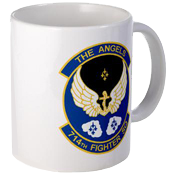Overview
The S/A-81 Hornet is a fixed-wing, single-seat, multi-purpose fighter. It is the only fighter in the Coalition Navy to hold a “superior” rating in both space and atmosphere environments. Hornet squadrons are typically carrier-borne; however, each Hornet possesses its own matter/anti-matter-based ether-drive, enabling, if need be, unassisted travel between star systems. The Hornet has been in active service for 20 years as the premiere fighter of the UCN.
History
In the waning days of the Frontier War as Coalition forces were pressing deep into FSA territory, there was a skirmish over Riksen, a frontier planet that had seen little action to that point. A squadron of Coalition SF-33 Adders engaged two flights of Alliance P-83s, battering the Lightnings without suffering any losses. After the initial furball, only two damaged P-83s remained. The pair of Lightnings made a dash for the planet with the full squadron of Adders in close pursuit. Pressing the engagement was a risk for the Adders—the SF-33, with its unique swivel-engine design, was a space superiority fighter, unqualified for atmospheric combat. However, the squadron commander, emboldened by the victory, ordered the Adders to press ahead, reasoning that, even at a disadvantage, a full squadron should easily be able to finish off a couple of wounded fighters.
What the commander did not account for was the Riksen Air Defense. As the Adders descended further into the Riksen atmosphere, they were met by a single flight of four archaic atmosphere-bound fighters. Despite having superior weapons, more powerful engines, and combat-tested pilots, the Adders were no match for Riksen fighters. The Adders responded sluggishly in the air and were physically incapable of matching the nimble maneuvers of the old fixed-wing fighters. It was a shooting gallery for the Riksen fighters—within minutes, the entire Adder squadron was destroyed.
While the Coalition went on to win the war, the Riksen debacle remained an embarrassment for the Navy. Thus, the S/A (Space/Atmosphere) program was born—a call to spacecraft manufacturers to design a fighter that could perform just as capably in atmosphere as in space. A few companies responded by taking their existing space superiority fighters and modifying them for atmospheric flight. Aurora Company, though, took the opposite approach—start with an atmosphere frame and make it space worthy.
After considering hundreds of atmospheric fighter designs, Aurora Company determined that the old Navy F/A-18 Hornet had the ideal frame from which to construct a dual-purpose fighter. It was a fitting choice, given the F/A-18’s history of versatility, and so the name “Hornet” and designation “S/A-81” were chosen as an homage to the old atmosphere-bound fighter. Aurora Company won the competition, the Hornet outclassing its competition in every performance category.
As a post-war fighter, S/A-81 Hornets have not had the opportunity to take part in any large-scale engagements. They have, though, seen regular action, defending Coalition space routes and planets against pirate raids, mercenaries, and factions loyal to the FSA. In its service history, the Hornet has achieved an impressive 15:1 strike/loss ratio—unprecedented in modern space combat.
Appearance
The old F/A-18 and the Aurora Company S/A-81 share the same basic frame, making the two fighters, separated by centuries, remarkably similar in appearance. Halfway back and midway up the fuselage, two lean wings angle back, their wingspan about two-thirds as wide as the fighter is long. Twin AI-530 thrust-vectoring engines—positioned side-by-side at the rear between the elevators—power the craft, while forward, dorsal, and ventral thrusters provide maneuvering capability in space. Rising up from the front of the engines is the Hornet’s most distinctive visual feature—a pair of vertical stabilizers that angle out slightly in the shape of a wide-bottomed “V.”
Armaments
As a multi-purpose fighter, the Hornet is designed to carry a wide range of armaments. Each Hornet is outfitted with a standardized projectile launcher with a twelve-missile capacity. Typical projectiles include the Advanced Ion Missile (AIM)—the standard sensor-guided projectile employed by Coalition fighters—and the Power Draining Missile (PDM)—a projectile that latches onto and drains power from a target, rendering it disabled.
For bombing missions, a Hornet can carry a single Heavy Ion Bomb (HIB). Designed to neutralize space stations, capital ships, and large planetary compounds, the rocket-powered HIB, while slow, packs a devastating punch. The Hornet carries the HIB on a centered ventral pylon attachment typically reserved for an external fuel tank.
Each Hornet is also armed with four V-cannons, which discharge battery-powered energy bolts. The forward two V-cannons are placed on either side of the Hornet’s nose, and the two rear-facing V-cannons are placed above and below the engines. The term “V-cannon” is an homage to the original F/A-18’s “Vulcan” cannon as well as a reference to the shape of the fire-pattern that a pair of cannons create.
Free-Firing Capability
The Hornet is unique from other Navy fighters in that its cannons are not locked into place but are able, instead, to swivel like turrets. The direction the V-cannons are facing is represented by a free-floating pipper that is projected onto the Heads Up Display (HUD) in the pilot’s visor. The cannons are controlled by a small thumb stick on top of the flight stick. This allows a Hornet pilot to engage a target even if the nose is not pointed directly at it. Some pilots ignore this capability, choosing to engage in traditional dogfighting by keeping their cannons locked forward at all times. Others base their entire strategy around “free-targeting,” purposefully flying past easier targets—strafing them on the way by—while getting into position behind more difficult targets.
Though “free,” the V-cannons cannot shoot in any direction—most notably, safe guards are in place to keep the cannons from being inadvertently pointed at the Hornet’s own wings or vertical stabilizers. And though the mobile V-cannons give Hornets a tactical advantage, a pilot still has the best chance of getting a kill by remaining in the “control zone”—the cone-shaped area directly behind a target.
Rear targeting with the rear V-cannons works in a similar way except that a portion of the main HUD switches to a rear view. Most pilots, however, find it all but impossible to fly in one direction while simultaneously firing rear V-cannons with any degree of accuracy. Several Hornet pilots, therefore, rely simply on automated firing solutions designed to chase targets off their tails. A handful of the most skilled Hornet pilots, though, maintain control of their rear cannons, taking pride in their ability to manually engage rear threats while pursuing new targets.
Conclusion
The Navy has faster fighters than the Hornet. There are fighters with more armaments and stronger armor. Some of the latest generation fighters have even been modified to include the free-firing V-cannon system. But no other fighter has yet to strike the perfect balance of the Hornet. In the proper hands, the S/A-81 Hornet is the most lethal fighter in the Coalition.





